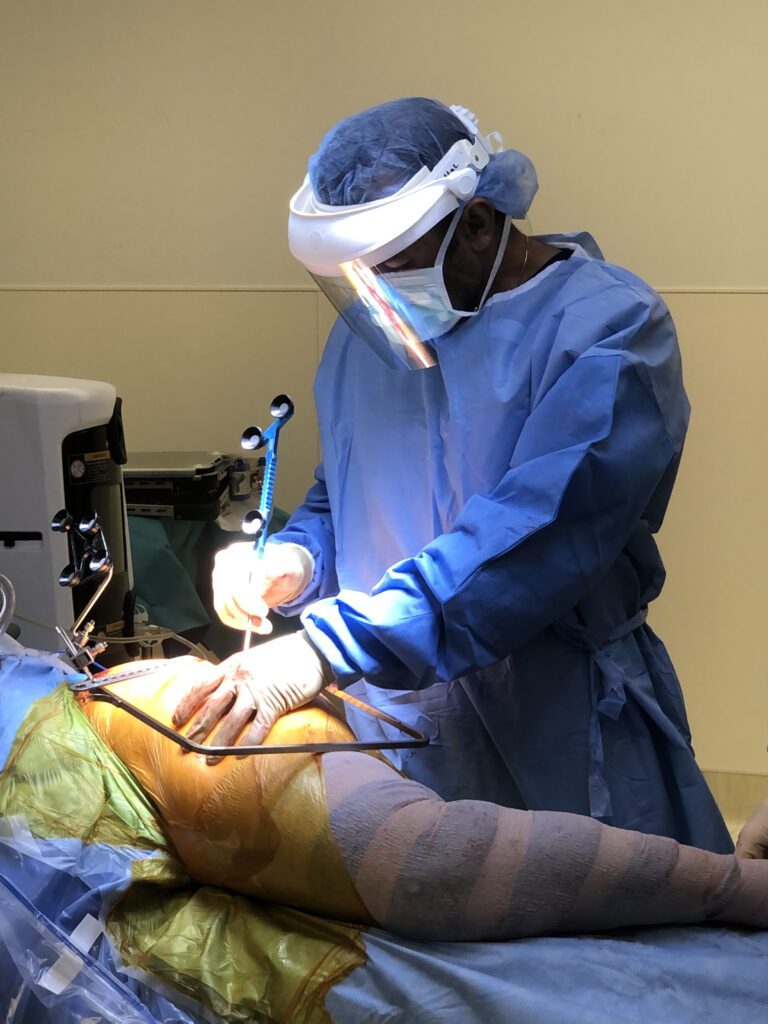The Brain
Keeping mentally sharp as we age is as important as staying physically fit. Our brain, like any other part of the body, benefits from a healthy lifestyle with efforts made to support and strengthen mental acuity.

“In addition to a healthy diet and regular exercise, individuals can keep their brain healthy by staying mentally active through activities like puzzles, reading and learning new skills,” says Kenny Susanto, M.D., a neurologist with Ascension St. John Medical Group. “Social engagement, quality sleep, stress management and staying hydrated are also helpful – and recognizing that mental health is an important aspect of our brain, I would also recommend doing mindfulness exercises and meditation.”
He says mental decline varies by individual and also depends on baseline cognitive capabilities.
“Common early symptoms may include forgetfulness, and more complex things such as getting lost in familiar places and/or forgetting how to do the sequence of things that one is used to doing tends to be more specific,” says Susanto.
While some changes can be mild and attributed to normal aging, he says if these changes begin to interfere with daily life, then it’s wise to consult a healthcare professional for evaluation. As treatment for dementia evolves, Susanto shares that a new drug was recently approved by the Food and Drug Administration to treat early Alzheimer’s disease.
“There are a lot of things being researched currently, not limited to medications, neuroimaging techniques and AI technologies,” he says.
The Eyes
Technological advancements in the field of ophthalmology are providing new treatments for a variety of diseases and conditions that affect the eye.
Victoria Bugg, M.D., an ophthalmologist with Dean McGee Eye Institute in Oklahoma City, says there are many new and exciting innovations that can help patients with glaucoma, cataracts and other vision conditions.

Photo courtesy Dean McGee Eye Institute
“Glaucoma is a disease of the optic nerve that can be associated with a higher eye pressure and can often be treated with eye drops,” says Bugg. “However, if surgery is needed, there are now several surgical procedures that are efficacious at lowering the eye pressure with less side effects than more traditional glaucoma surgery.”
Some of these surgeries can be done at the same time as cataract surgery, and patients should talk to their ophthalmologist to see if they would be a good candidate for one of these treatments.
Fuchs endothelial dystrophy, a disease that causes corneal swelling and blurry vision, previously required a full thickness cornea transplant when it reached the end stages.
“Today, cornea surgeons are able to do a partial transplant of only the most posterior portion of the cornea,” says Bugg. “This procedure is significantly less invasive than a full thickness corneal transplant, and has less risk for complications during surgery and afterwards.”
Cataract surgery, Bugg’s specialty, allows individuals to not only treat the cataract, but also correct their vision.
“Everyone is born with a lens inside their eye, which can become cloudier and cause blurry vision as we age. At that point, it’s considered a cataract,” she says. “We do the surgery as an outpatient, under local anesthesia. While looking under a microscope, we make small incisions on the side of the eye, break up the cataract lens, and vacuum it out. We then place an acrylic lens inside the eye that will stay there forever, and there are a variety of lens implants available that can help correct nearsightedness, farsightedness or astigmatism.”
However, with any surgery, there are risks and potential side effects.
“Before any eye procedure, I encourage everyone to have an in-depth conversation with their surgeon to ensure the benefits outweigh the risks,” says Bugg.
The Joints
Healthy shoulder and hip joints are critical to mobility – allowing us to move freely and easily throughout our daily activities. But sometimes, injuries, disease or chronic wear and tear can limit our movements, and relief may only be found through a surgical procedure.
“While most people would like to avoid surgery – and we do try many nonsurgical options – there are times when surgery is what’s needed to correct a problem,” says Jacob Worsham, M.D., an orthopedic sports medicine surgeon with Tulsa’s Advanced Orthopedics of Oklahoma. “With any treatment plan or procedure, our goal is to help our patients return to doing the things they enjoy.”

Photo courtesy Advanced Orthopedics
Common shoulder surgeries include rotator cuff, labrum, impingement, fracture repairs and shoulder replacement.
Worsham says there are two main types of shoulder surgeries – an arthroscopic procedure where small keyhole incisions are made in the shoulder for a scope and other instruments to be inserted; and an open shoulder procedure, where a single large incision is made into the shoulder. The type of surgery required is dependent upon the diagnosis.
For shoulder replacement surgery, the diagnosis is usually arthritis or a nonfunctional rotator cuff; options include a partial shoulder replacement, anatomic total shoulder replacement or reverse total shoulder replacement.
“If the rotator cuff is intact, then a normal or anatomic shoulder replacement can be performed. However, if you have any deficiencies in the rotator cuff muscles, then you may need a reverse total shoulder replacement,” he says.
With a reverse total shoulder replacement, the implant is placed backwards with the ball attached to the shoulder bone and the socket attached to the upper arm bone or humerus.

Photo courtesy The Orthopaedic Center
“By switching the ball and the socket, your deltoid muscle takes over the function of lifting your arm,” says Worsham.
For a partial shoulder replacement, also called a shoulder hemiarthroplasty, only the humeral head is replaced.
“Shoulder replacements are very successful, and when done for the right patient and right diagnosis, it can really change people’s daily lives by allowing greater mobility,” he says.
Yogesh Mittal, M.D., an orthopedic surgeon with the Orthopaedic Center in Tulsa, says patients who are candidates for hip replacement surgery have usually tried a variety of other treatment options, including medication, injections, physical therapy and weight loss to alleviate pain – but with no success.
“If your hip is keeping you from being happy and doing the things you want, whether it be from pain or loss of function, please consult a surgeon,” he says. “We can help in so many ways. We now have better implants with better bearing surfaces that wear better and last longer – usually 15 years is ideal, but they last even longer at times. Also, recent advances include robotic technology, which has revolutionized the industry and improved the surgical experience immensely.”
The Mouth
Third molars, called wisdom teeth, are located in the back corners of the mouth, both on the top and bottom, and have the potential of being painful problems.
“Often, wisdom teeth begin to cause pain and discomfort in the teenage years or early twenties,” says Cody H. Mumma, DDS, an oral and maxillofacial surgeon with Eastern Oklahoma Oral & Maxillofacial Surgery in Tulsa. “Many times, wisdom teeth become impacted, or stuck in the gums and bone. Swelling and pain of the gums overlying a wisdom tooth is often the first symptom, and this can eventually lead to a cavity with more pain and discomfort.”
Along with the possibility of infection, an impacted wisdom tooth can also develop a follicular cyst around the impaction and, as it grows, can damage the surrounding jaw bone and teeth.
“My best advice is to remove wisdom teeth early. As we age, wisdom teeth become more challenging to remove and complications can occur more often,” says Mumma. “While the procedure of removing wisdom teeth hasn’t changed much, I would encourage those seeking removal of their wisdom teeth to consult with an oral and maxillofacial surgeon, as we are specially trained in this procedure and the complications that can occur.”
The Heart
The American Heart Association and American College of Cardiology recently updated its chronic coronary disease guidelines. Aleicia Mack, D.O., a cardiologist with INTEGRIS Health Heart Hospital in Edmond, explains the importance of these recommendations and their effect on caring for those with heart disease.
“Clinical practice guidelines have a direct impact on the daily treatment and care of patients with coronary artery disease,” says Mack. “These guidelines were created to offer evidence-based recommendations for managing patients at different stages of the disease, from those at risk to those with a confirmed diagnosis. The ultimate objective is to provide patient-centered, high-quality care.”

Photo courtesy INTEGRIS Health Heart Hospital/Ackerman McQueen
She says one main focus within the guidelines is to continue “adopting a patient-centered, team approach to cardiovascular care with an emphasis on lifestyle changes, such as healthy eating and regular physical activity in addition to medical therapy.”
For instance, for anyone living with heart disease or trying to avoid it, there are many best practices to follow – from avoiding trans fat and certain medications to limiting exposure to secondhand smoke. Studies have shown that adults who are exposed to secondhand smoke increase their risk of developing coronary heart disease by 25-30% and exposures as brief as 30 minutes can result in damage to blood vessels and tissue.

Photo courtesy Norman Regional Health System
The Lungs
According to the American Lung Association, more than 34 million Americans live with a chronic lung disease. Additionally, lung cancer is the leading cause of cancer deaths in the United States.
Sergio Garcia, M.D., a pulmonologist with Norman Regional Health System, says there are many common causes of lung disease.
“For example, smoking is associated with COPD (chronic obstructive lung disease), cancers and some interstitial lung diseases, and environmental factors may affect us and predispose us for asthma or interstitial lung diseases,” says Garcia. “Also, many types of cancer of the lung exist and are treated differently and behave differently.”
He says risk factors, beyond smoking, include radon and asbestos exposure – but it’s also important to know that 25% of new lung cancer cases occur in people who have never smoked.
“The most common symptoms of lung disease include breathlessness, a persistent cough, weight loss, wheezing, fatigue, chest pain, mucus production and coughing up blood,” says Garcia, adding that lung cancer screenings are a regular preventative health check. “A lung cancer screening is meant to find lung cancer at an earlier stage, when survival rates are better. You should consider getting screened for lung cancer if you are aged 50 to 80 years old, smoke now or quit within the past 15 years, and have a 20-pack a year history.”

The Stomach
These days, people are paying more attention to their gut health – a broad term used to describe the body’s digestive system – and a healthy stomach is essential for a healthy gut.
Scott Hendrickson, D.O., a gastroenterologist with Gastroenterology Specialists in Tulsa, says to maintain a healthy stomach it’s important to reduce your consumption of known irritants.
“Examples of these include excessive alcohol, smoking and NSAIDS [like] ibuprofen and naproxen,” he says. “And some acid blocking drugs – omeprazole, pantoprazole – can drastically increase the pH in the stomach, which affects the digestion of foods and minerals and can lead to overall poor gut health.”
He also recommends avoiding or limiting your intake of processed meats, salt-cured foods, fried foods and artificial sweeteners.
“There is some evidence that frequent consumption of charred meats – charcoaling, smoking – and foods cooked at very high temperatures can produce carcinogens which may contribute to stomach cancer,” he says.
Inflammation of the stomach lining, called gastritis, can present a variety of symptoms, says Hendrickson, including upper abdominal pain, nausea, early fullness or pain after eating.
“Stomach ulcers are a more severe and deep disruption of the stomach lining,” he says. “Symptoms can be abdominal pain, bleeding and anemia, and most of the symptoms common to gastritis. Ulcers can be caused by NSAIDs, a bacteria called H. pylori, cancer and other causes.”
Distinguishing stomach problems from other areas of the digestive tract, such as the small bowel and colon, can be difficult. If symptoms are persistent or severe, Hendrickson says to visit your primary care physician or a gastroenterologist to be evaluated and receive the appropriate treatment.

Photo courtesy Tulsa ER & Hospital
The Importance of Emergency Medicine
Remaining calm and working quickly and efficiently during a medical crisis are just parts of the job for emergency medicine physicians. Mark Blubaugh, D.O., partner and medical director at Tulsa ER & Hospital, says the ability to make informed decisions under high-stress conditions is paramount.

Photo courtesy Excel Therapy
“Rapidly identifying the underlying cause of a patient’s symptoms is crucial, as well as the ability to assess complex situations, prioritize interventions and adapt strategies in limited time and often with limited information,” says Blubaugh. “The ability to work collaboratively, delegate tasks and lead a team is vital, and emotional resilience is essential to maintain composure and cope with difficult situations.”
When emergency medicine physicians assess a patient in physical distress, Blubaugh says they follow a structured approach to quickly manage the situation. While exact steps and decisions will vary, the process begins with a primary assessment.
“The physician begins by quickly evaluating the patient’s general condition and addressing immediate life-threatening issues,” he says. “This is often done using the ‘ABC’s’ – Airway, Breathing and Circulation. Ensuring the patient has a patent airway for breathing, assessing the patient’s breathing pattern, rate and effort, and checking the patient’s heart rate, blood pressure and perfusion.”
After ensuring the ABC’s are stable, physicians then begin the standard history and physical exam to further assess the patient’s condition, and additional tests and treatments may be required for diagnosis and care. While some patients are discharged, others may need surgery or a stay in the intensive care unit (ICU).
Blubaugh says those in emergency medicine think differently about patient care than most specialties. Identifying the most potentially dangerous life or limb-threatening conditions is first and foremost – and while a definitive diagnosis may not be achieved during the emergency visit, patients can be reassured that, if possible, their emergent conditions will be stabilized.
The Pros of Physical Therapy
Mike Flanary, physical therapist and co-owner of Excel Therapy, says physical therapy can be beneficial to anyone who is having pain or physical limitations in performing daily activities, recreational activities, or due to a sports-related injury, surgery or just a gradual onset of symptoms.
“Any orthopedic – muscle, tendon, bone or joint – problem can be treated by a physical therapist, but the most common body parts are shoulder, knee, hip, neck, back, foot and ankle,” says Flanary. “Physical therapists focus on improving a patient’s mobility, strength, movement and posture based on each individual’s needs to help them reach their goals and improve their functional ability. Although physical therapy may require a person to attend two to three times per week, the benefits outweigh the alternative.”
While some may consider physical therapy as being only exercises such as stretching or strengthening, Flanary says many other treatments can be applied based upon a patient’s condition.
“Other techniques, such as functional dry needling, instrument-assisted soft tissue mobilization (Astym®), muscle energy techniques and manual therapy techniques can be applied to an individual’s treatment plan,” he says. “In Oklahoma, direct access allows you to be treated by a physical therapist for up to 30 days without a prescription for physical therapy – except Medicare, Medicaid or worker’s compensation, which requires a prescription. Most, if not all, insurances cover physical therapy.”
Vertigo’s Prevalence
Sudden dizziness or the sensation that you’re spinning when you’re not is called vertigo. And while not a disease itself, it can be a symptom of many other health conditions.
There are two main types of vertigo: peripheral and central. The most common, peripheral, is caused by issues with the inner ear or vestibular nerve, which is responsible for helping maintain balance. Subtypes of peripheral vertigo include benign paroxysmal positional vertigo (BPPV), labyrinthitis, vestibular neuritis and Ménière’s disease. Central vertigo occurs when an individual is suffering from a condition affecting the brain, such as an infection, stroke or traumatic brain injury.

Photo courtesy Saint Francis
Since most people are unaware of when vertigo will strike and how long an episode will last, it’s critical to visit a physician – often an ear, nose and throat (ENT) specialist – to determine the cause of the vertigo. When experiencing vertigo, a few recommendations to help ease the dizziness are to move slowly when standing or turning your head; lying in a dark, quiet room; squatting down instead of bending over at the waist when picking something up; sleeping with your head elevated on pillows; and taking care to reduce the potential of falls.
Source: Cleveland Clinic
Stroke: Know the Signs
According to the Stroke Awareness Foundation, ischemic strokes represent about 87% of all strokes. Within 59 seconds, an ischemic stroke can potentially kill 1.9 million brain cells and cause varying levels of disability. In an ischemic stroke, a blood vessel becomes blocked by a blood clot and cuts off oxygen to a portion of the brain.
“When a patient has suffered an ischemic stroke, there are a variety of prognosis factors used, such as the NIH stroke scale score, where the greater the score means the greater severity of stroke, and imaging studies like MRIs and CT scans,” says Steven Hoover, M.D., an interventional neurologist with Saint Francis Health System in Tulsa. “But if a clot is cleared quickly enough, even with a severe stroke, patients can have a positive outcome.”

Photo courtesy Ascension St. John Health System
The most common drugs used to break up a clot that is disrupting the blood flow within the brain is thrombolytics, and ideally they should be given within three hours of experiencing a stroke to prevent long-term damage.
“The advent of thrombolytic agents was a big change in stroke care,” says Hoover. “Previously, we didn’t have any way to lessen the severity of the stroke and could only offer patients supportive care and treatments.”
Other technology that changed the landscape of stroke treatment has been the mechanical thrombectomy – a minimally invasive procedure using specialized equipment to surgically remove the blood clot.
“The mechanical thrombectomy has tremendously improved the outcome for stroke patients and, depending upon a patient’s condition, can be conducted within 24 hours after a stroke,” he says. “However, with all stroke care, the earlier treatment is received, the better.”






















